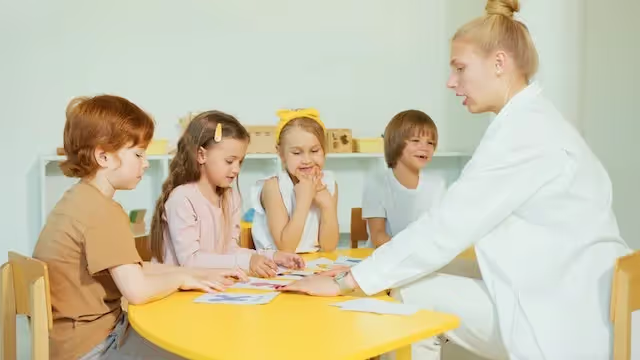Errorless Learning In ABA: Complete Guide
Errorless learning deals with the prompting of different targets, helping the responses of clients in therapy be accurate.


What Is Errorless Learning/Teaching?
Errorless learning deals with the prompting of different targets, helping the responses of clients in therapy be accurate.
Such prompts, when done correctly, affirm success with people taking ABA courses.
After students familiarize themselves with behaviors that are targeted, prompting over time fades. When this occurs, clients can respond in the right way without being prompted again.
When prompts are done at an early stage of a child's development, they raise the likelihood of:
- Success in therapy is shown at an early stage in the client's life
- Prompts fade out as time passes
- Clients respond in different situations without being encouraged to do it by their therapist, parent, guardian, or teachers
Overall, errorless learning can help raise client motivation when in a learning environment, which later expands into everyday life for their betterment.
Examples of Errorless Learning
Here are some examples of errorless learning, involving a teacher.
Mr. Scott teaches a six-year-old student that's been diagnosed with autism. He decides to try errorless learning in helping the student become aware of the different varieties of shapes.
Step 1
Using the first step in the process, Mr. Scott decides to begin by having the child identify a circle. He starts by having them pick a circle in a multiple-choice exercise where two other shapes are included, a triangle and a rectangle. Over three back-to-back sessions, the student gets the shape correct 80% of the time.
Step 2
Mr. Scott moves on to step 2 in the exercise. Based on previous interactions with the student, he thinks that visual prompts would assist them in responding with more accurate answers. He sets up flash cards where a circle appears in black, while the other shapes are bright gray.
Step 3
Mr. Scott starts by putting down three flashcards on a table for the direct attention of the student. He asks the student to pinpoint the circle.
Once the student begins to point toward the incorrect shape, he benevolently takes their hand and helps guide them toward the right flash card, which is the circle. After verbally saying what the shape is to the student, Mr. Scott then awards them with their favorite piece of candy.
Step 4
Mr. Scott does the previous steps again, giving reinforcement every time his student picks the circle flash card. After the third time that they correctly pick the right card, Mr. Scott takes out another set of rectangle and triangle cards.
They're slightly darker than the bright gray cards used before. At the same time, Mr. Scott gives reinforcement every time the response is a correct one.
The prompt gradually faded through the introduction of darker alternative shapes through the trials, up until the triangles and rectangles became as dark as the circle. It's at this moment that the student can pinpoint the correct flash card without the use of any prompts.
How to Use Errorless Learning
Errorless learning is used with physical, verbal, and visual prompts. Each one can be partitioned. A verbal prompt, for instance, might be partial, like a question that can't be answered simply.
Using errorless prompting should always begin with intrusive prompts, going down until the client finishes the entire task. If the client needs a verbal prompt to give the correct response, teaching should begin at that prompt level and fade out after the student shows success.
Physical prompts
Physical prompts require contact with the practitioner and the client. There are lots of schools that use physical prompts in some way. Therefore, the rule could be different depending on the school it's used in.
Verbal prompts
Verbal prompts consist of those which are and aren't direct. Being less intrusive, an indirect prompt is recommended first. It should begin with a question that can't be answered with a simple response. However, if this isn't effective, a verbal response can be used.
Visual prompts
Visual prompts use cues given to clients to help them figure out what they can do, or which answer is the right one. They go by stimulus, model, gestural and positional prompts.
Least to Most (LTM)
In the least to most prompt fading, the teacher finds out the prompt that's needed and starts with an intrusive one. In this situation, the beginning trial involves physical prompts since the student can't finish the task with no physical prompts being used.
Most to Least (MTL)
Studies show that the most to least prompt results in fewer errors by clients during every session.
Skills can also be picked up quicker this way, even faster than the least to the most method. Its use is advisable when errors lower a client's ability to learn or raise certain behaviors deemed problematic.
Recent News
Related articles

Working With Autistic Children: 10 Career Options
Want to work with autistic children? Here are 10 career options for you to consider.

What Is The Age Limit For ABA Therapy In Indiana?
Find out what the age limit is for receiving Applied Behavior Analysis (ABA) therapy in Indiana.

What Is The Age Limit For ABA Therapy In Arizona?
Find out what the age limit is for receiving Applied Behavior Analysis (ABA) therapy in Arizona.

Verbal Operants In ABA: Definition & Examples
In Applied Behavior Analysis, verbal operants are a type of verbal behavior.

Token Economy: Examples & Applications in ABA
A token economy is a procedure that was developed to help reduce maladaptive behaviors and increased desire behaviors by providing a tangible conditioned reinforcer.

Trigger Analysis In ABA: Definition & Examples
Trigger analysis is a segment of ABA therapy where children are taught by therapists to pinpoint the behaviors and emotions that happen before, during, and after an event that takes place.

Variable Ratio Schedule & Examples
A variable-ratio schedule is a random reinforcement where responses are reinforced following varied responses afterward.

Task Analysis In ABA Therapy: Examples & Strategies
Task analysis is a process of teaching that divides complicated activities into sections involving easier steps for students to more easily take.

Stimulus Equivalence In ABA: Definition & Examples
Stimulus equivalence shows how relationships can manifest among different types of stimuli in different situations.

Speech Therapy For Autism: ABA vs. Speech Therapy
ABA therapy can help individuals with speech impairments learn to better identify and utilize the language skills they already have.

Stimulus Control Transfer ABA: Definition & Examples
Stimulus control is defined as an expression used to detail circumstances where a behavior is triggered by the existence or absence of a stimulus.

Social Validity In ABA: Definition & Examples
Social validity is the acceptance of interventions concerning behavioral changes.

